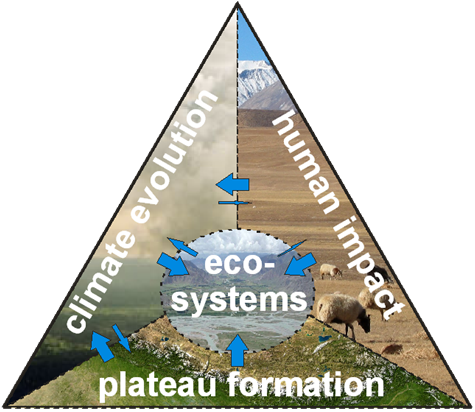Diplomarbeit
Effect of intensive grazing on carbon pools and fluxes in a montane grassland on the Tibetan plateau
Sebastian Unteregelsbacher (03/2010-01/2010)
Betreuer: Yakov Kuzyakov
Geoökologie, Univ. Bayreuth
Within the Qinghai-Tibetan Plateau (TP), the Kobresia pastures represent the world’s largest montane-alpine grassland ecosystem, which has appeared to be quite stable during the last centuries or millennia of nomadic animal husbandry. Since the Chinese admini-stration launched a multitude of programs to change traditional herding in the Tibetan highlands, sedentarisation programs (land use changes) lead to pronounced overgrazing with consequences for the vegetation and soils. Therefore it has to be discussed if the present grassland patterns are a result of overgrazing. A common pattern in the whole of the Tibetan Kobresia pastures are patches of turf, only covered by crustose lichens and algae in between the Kobresia pastures and other grassland species . Our question is if this pattern may strongly affect the carbon (C) cycle. Low molecular weight organic sub-stances (LMWOS) such as root exudates are the most dynamic C pool and therefore react more sensitively to changes. To identify differences in decomposition rates and fate of LMWOS in grassland plots (both crust and non-crust) we uniformly added 13C labeled glucose, glycine and acetic acid, representing the three main groups of LMWOS in soil. After addition we followed the subsequent evolution of 13CO2 (decomposition of 13C-labelled substances and metabolites) from the soil, 13C remaining in the soil, and uptake of LMW dissolved organic carbon (DOC) by plants, after the pulse labeling during 29 days (July - August 2009). A single first-order decay equation fitted the experimental data of 13CO2 evolution well and gave decomposition rates (k) of 0.70-0.73 d-1 for glu-cose, 1.42-1.53 d-1 for glycine and 1.08-1.33 d-1 for acetic acid which indicate a rapid de-composition of initial substances for crust and non-crust, respectively. However, no sig-nificant (P>0.05) differences in decomposition rate were found between the crust and non-crust soils. Overall, about 31-38% of 13C-glucose, 55-66% of 13C-glycine and 30-40% of 13C-acetic acid remained in the soil (0-30 cm) 29 days after labeling. The remain-ing 13C in soil was significant lower (P<0.001) for the non-crust treatments. After 29 days of labeling very high amounts of the added 13C were recovered in plant biomass for non-crust plots (about 16% for 13C-glucose, 31% for 13C-glycine and 10% for 13C-acetic acid) indicating that grassland plants (Kobresia species) with dense root system could be competitors for LMWOS in comparison to soil microorganisms. CO2 efflux from soil was measured by alkali absorption (AA) and closed chamber (CC) method. Mean CO2 efflux rates obtained by the AA and CC methods were in the ranges 5.09-5.44 g CO2-C m-2 d-1 and 4.0-4.34 g CO2-C m-2 d-1 for crust and non-crust, respectively. The higher CO2 efflux rates for the non-crust treatments, resulting from higher root and rhizomicrobial respiration. Linear relationship between root biomass and CO2 efflux from soil showed that root derived CO2 contribution to total CO2 efflux from soil was 18.2% for crust and 23.4% for non-crust. The results based on three 13C labeled substances showed differ-ences in C dynamics between the two contrast patches of vegetation (crust and non-crust) resulting from overgrazing. However, no alteration concerning long-term stored soil or-ganic carbon (SOC) was found. Therefore, we assume that montane Kobresia pastoral ecosystems, respond slowly to changes and can be suspected to be a stable grazing eco-system.
Key words: Overgrazing; Land use changes; Kobresia pasture; Low molecular weight organic substances (LMWOS); 13C pulse labeling; CO2 efflux from soil; Soil organic carbon; SOC

